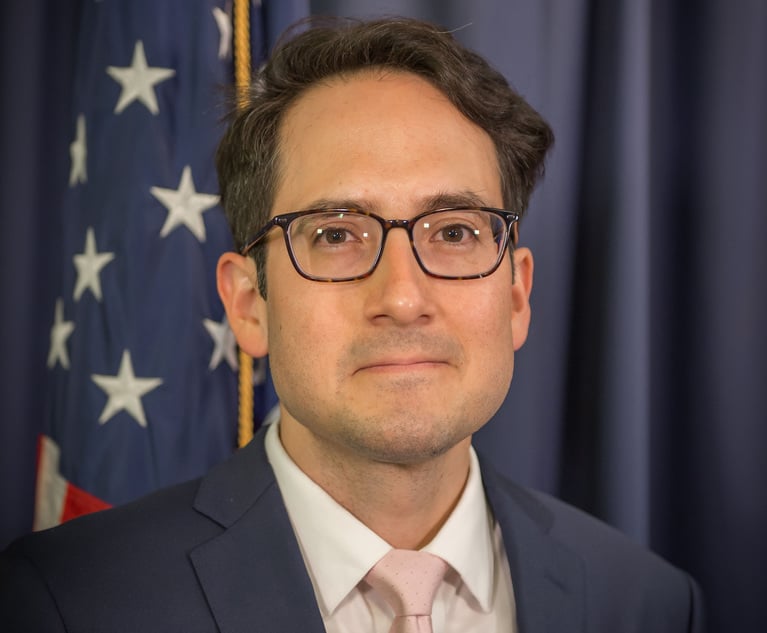IP: Roadblocks, detours and dead ends on the top-level domain journey
For some applicants for new generic Top-Level Domains (gTLDs), the journey from application to delegation may not be quite as easy as a Sunday drive, but it likely will be fairly uneventful.
October 16, 2012 at 07:25 AM
11 minute read
The original version of this story was published on Law.com
For some applicants for new generic Top-Level Domains (gTLDs), the journey from application to delegation may not be quite as easy as a Sunday drive, but it likely will be fairly uneventful. The Internet Corporation for Assigned Names and Numbers (ICANN) expects an estimated 90 percent of applications will need to answer at least one clarifying question from the Initial Review committees, most of which likely will focus on financial consideration, including letters of credit, security policy and independent security assessments. Pending satisfactory answers to these questions, however, “straightforward” applications (those not subject to extended evaluation, formal objection or string contention proceedings) would proceed to the delegation phase without any significant detours or delays along the way. Many other applicants, including the largest players in the process, however, may meet multiple roadblocks, detours and delays—some anticipated and others perhaps unexpected—on the road to delegation. And at least 25 percent (and probably significantly more) will arrive at a dead end from which no alternate route exists.
Dead Ends: No Outlets and No U-turns
Only one applicant can succeed in obtaining any one gTLD, and all other applications in the contention set for that domain—both identical strings and those found sufficiently similar—will be at a dead end. For example, of the 13 applications for .APP, one applicant (if any) can obtain the domain, 12 will not. Given that nearly 40 percent of the applications (751) are vying for 230 identical domains (plus those similar strings also in contention), at least 520 applications (more than 25 percent of the total applications) ultimately will fail. In addition, applicants for community-based TLDs in contention with other applications may elect community-priority evaluations. If the application meets the criteria for that evaluation, only other contending community-based applications will be included. Any standard application in contention automatically reaches a dead end.
Formal objections can also send an application down a dead end. Parties with standing may submit formal objections on four grounds—string confusion, legal rights, limited public interest, and community objection. String confusion objections are limited to claims of confusing similarity between either an existing TLD or another applied-for gTLD string, and are not available to nonapplicants. While a successful string confusion objection by an existing TLD operator terminates the application, a successful objection by another applicant causes both applications to be referred to string contention resolution.
Legal rights objections allow any “rights holder” to assert that a gTLD string infringes rights “that are recognized or enforceable under generally accepted and internationally recognized principles of law.” While no legal rights objections exist for generic terms, parties may object if “the potential use of the applied-for gTLD by the applicant takes unfair advantage of the distinctive character or the reputation of the objector's registered or unregistered trademark or service mark.” Legal rights objections, filed with The Arbitration and Mediation Center of the World Intellectual Property Organization, can result in a quick remedy for objectors—and a quick trip to a dead end for applicants.
Limited public interest objections, available to both applicants and nonapplicants, assert that the applied-for string is contrary to generally accepted legal norms of morality and public order recognized under international law. The objection is subject to a “quick look” review to filter out frivolous or abusive objections. Finally, community objections are available only to established institutions associated with clearly defined communities, and assert that substantial opposition exists to a gTLD application from a significant percentage of the community. This objection is not limited to community-based applications. For example, of the eight applications for .MUSIC, only two are designated as community-based. As long as an objector meets the standing requirement, however, it could file an objection against all eight of the applications, the six standard applications, as well as the two community-based applications.
While lodging an objection involves a significant commitment of resources and should not be undertaken lightly, the process can secure the denial or withdrawal of an application. Applicants have three options: reach a settlement that results in withdrawal of either the objection or the application, withdraw the application or file a response and enter the dispute resolution process. Having invested a minimum of $185,000 in the gTLD application, applicants likely will be reticent to withdraw their applications, yet the additional time and money required for responding to objections can be significant, particularly for companies with multiple applications or with applications that draw objections from more than one party.
Other detours and delays
As we discussed in Wrong turns and other directional changes in the road to new gTLDs, applicants that submit a request for a change to their applications will experience a delay of at least 30 days during which ICANN holds all amended applications for public comments. ICANN also reserves the right to resubmit materially amended applications for initial evaluation, essentially sending the application back to the beginning of the process.
While the public comment period officially closed on Sept. 26, comments continue to impact the gTLD application process. Comments directed at the evaluation panels and lodged before the close of the official comment period are considered during the initial evaluation, and comments made on objection grounds are available for viewing by the independent objector and dispute resolution service providers. Comments made after Sept. 26 remain available for public viewing, although they are not required to be considered by the evaluation panels.
The Governmental Advisory Committee (GAC) also will consider comments in determining whether to issue any early warnings or formal advice. GAC formal advice creates a presumption that the ICANN board should block a particular application, and likely signals the end of the road for such applications. GAC formal advice is not scheduled to be released until April 2013, but GAC Early Warnings will be issued later this month. Applicants targeted by the GAC early warnings may opt to withdraw from the gTLD application process with an 80 percent refund of the application fee.
For some applicants for new generic Top-Level Domains (gTLDs), the journey from application to delegation may not be quite as easy as a Sunday drive, but it likely will be fairly uneventful. The Internet Corporation for Assigned Names and Numbers (ICANN) expects an estimated 90 percent of applications will need to answer at least one clarifying question from the Initial Review committees, most of which likely will focus on financial consideration, including letters of credit, security policy and independent security assessments. Pending satisfactory answers to these questions, however, “straightforward” applications (those not subject to extended evaluation, formal objection or string contention proceedings) would proceed to the delegation phase without any significant detours or delays along the way. Many other applicants, including the largest players in the process, however, may meet multiple roadblocks, detours and delays—some anticipated and others perhaps unexpected—on the road to delegation. And at least 25 percent (and probably significantly more) will arrive at a dead end from which no alternate route exists.
Dead Ends: No Outlets and No U-turns
Only one applicant can succeed in obtaining any one gTLD, and all other applications in the contention set for that domain—both identical strings and those found sufficiently similar—will be at a dead end. For example, of the 13 applications for .APP, one applicant (if any) can obtain the domain, 12 will not. Given that nearly 40 percent of the applications (751) are vying for 230 identical domains (plus those similar strings also in contention), at least 520 applications (more than 25 percent of the total applications) ultimately will fail. In addition, applicants for community-based TLDs in contention with other applications may elect community-priority evaluations. If the application meets the criteria for that evaluation, only other contending community-based applications will be included. Any standard application in contention automatically reaches a dead end.
Formal objections can also send an application down a dead end. Parties with standing may submit formal objections on four grounds—string confusion, legal rights, limited public interest, and community objection. String confusion objections are limited to claims of confusing similarity between either an existing TLD or another applied-for gTLD string, and are not available to nonapplicants. While a successful string confusion objection by an existing TLD operator terminates the application, a successful objection by another applicant causes both applications to be referred to string contention resolution.
Legal rights objections allow any “rights holder” to assert that a gTLD string infringes rights “that are recognized or enforceable under generally accepted and internationally recognized principles of law.” While no legal rights objections exist for generic terms, parties may object if “the potential use of the applied-for gTLD by the applicant takes unfair advantage of the distinctive character or the reputation of the objector's registered or unregistered trademark or service mark.” Legal rights objections, filed with The Arbitration and Mediation Center of the World Intellectual Property Organization, can result in a quick remedy for objectors—and a quick trip to a dead end for applicants.
Limited public interest objections, available to both applicants and nonapplicants, assert that the applied-for string is contrary to generally accepted legal norms of morality and public order recognized under international law. The objection is subject to a “quick look” review to filter out frivolous or abusive objections. Finally, community objections are available only to established institutions associated with clearly defined communities, and assert that substantial opposition exists to a gTLD application from a significant percentage of the community. This objection is not limited to community-based applications. For example, of the eight applications for .MUSIC, only two are designated as community-based. As long as an objector meets the standing requirement, however, it could file an objection against all eight of the applications, the six standard applications, as well as the two community-based applications.
While lodging an objection involves a significant commitment of resources and should not be undertaken lightly, the process can secure the denial or withdrawal of an application. Applicants have three options: reach a settlement that results in withdrawal of either the objection or the application, withdraw the application or file a response and enter the dispute resolution process. Having invested a minimum of $185,000 in the gTLD application, applicants likely will be reticent to withdraw their applications, yet the additional time and money required for responding to objections can be significant, particularly for companies with multiple applications or with applications that draw objections from more than one party.
Other detours and delays
As we discussed in Wrong turns and other directional changes in the road to new gTLDs, applicants that submit a request for a change to their applications will experience a delay of at least 30 days during which ICANN holds all amended applications for public comments. ICANN also reserves the right to resubmit materially amended applications for initial evaluation, essentially sending the application back to the beginning of the process.
While the public comment period officially closed on Sept. 26, comments continue to impact the gTLD application process. Comments directed at the evaluation panels and lodged before the close of the official comment period are considered during the initial evaluation, and comments made on objection grounds are available for viewing by the independent objector and dispute resolution service providers. Comments made after Sept. 26 remain available for public viewing, although they are not required to be considered by the evaluation panels.
The Governmental Advisory Committee (GAC) also will consider comments in determining whether to issue any early warnings or formal advice. GAC formal advice creates a presumption that the ICANN board should block a particular application, and likely signals the end of the road for such applications. GAC formal advice is not scheduled to be released until April 2013, but GAC Early Warnings will be issued later this month. Applicants targeted by the GAC early warnings may opt to withdraw from the gTLD application process with an 80 percent refund of the application fee.
This content has been archived. It is available through our partners, LexisNexis® and Bloomberg Law.
To view this content, please continue to their sites.
Not a Lexis Subscriber?
Subscribe Now
Not a Bloomberg Law Subscriber?
Subscribe Now
NOT FOR REPRINT
© 2025 ALM Global, LLC, All Rights Reserved. Request academic re-use from www.copyright.com. All other uses, submit a request to [email protected]. For more information visit Asset & Logo Licensing.
You Might Like
View All
GOP Now Holds FTC Gavel, but Dems Signal They'll Be a Rowdy Minority
6 minute read


Longtime Purdue GC Accused of Drunken Driving Hires Big-Name Defense Attorney
3 minute readTrending Stories
- 1Big Law Firms Sheppard Mullin, Morgan Lewis and Baker Botts Add Partners in Houston
- 2Lack of Jurisdiction Dooms Child Sex Abuse Claim Against Archdiocese of Philadelphia, says NJ Supreme Court
- 3DC Lawsuits Seek to Prevent Mass Firings and Public Naming of FBI Agents
- 4Growth of California Firms Exceeded Expectations, Survey of Managing Partners Says
- 5Blank Rome Adds Life Sciences Trio From Reed Smith
Who Got The Work
J. Brugh Lower of Gibbons has entered an appearance for industrial equipment supplier Devco Corporation in a pending trademark infringement lawsuit. The suit, accusing the defendant of selling knock-off Graco products, was filed Dec. 18 in New Jersey District Court by Rivkin Radler on behalf of Graco Inc. and Graco Minnesota. The case, assigned to U.S. District Judge Zahid N. Quraishi, is 3:24-cv-11294, Graco Inc. et al v. Devco Corporation.
Who Got The Work
Rebecca Maller-Stein and Kent A. Yalowitz of Arnold & Porter Kaye Scholer have entered their appearances for Hanaco Venture Capital and its executives, Lior Prosor and David Frankel, in a pending securities lawsuit. The action, filed on Dec. 24 in New York Southern District Court by Zell, Aron & Co. on behalf of Goldeneye Advisors, accuses the defendants of negligently and fraudulently managing the plaintiff's $1 million investment. The case, assigned to U.S. District Judge Vernon S. Broderick, is 1:24-cv-09918, Goldeneye Advisors, LLC v. Hanaco Venture Capital, Ltd. et al.
Who Got The Work
Attorneys from A&O Shearman has stepped in as defense counsel for Toronto-Dominion Bank and other defendants in a pending securities class action. The suit, filed Dec. 11 in New York Southern District Court by Bleichmar Fonti & Auld, accuses the defendants of concealing the bank's 'pervasive' deficiencies in regards to its compliance with the Bank Secrecy Act and the quality of its anti-money laundering controls. The case, assigned to U.S. District Judge Arun Subramanian, is 1:24-cv-09445, Gonzalez v. The Toronto-Dominion Bank et al.
Who Got The Work
Crown Castle International, a Pennsylvania company providing shared communications infrastructure, has turned to Luke D. Wolf of Gordon Rees Scully Mansukhani to fend off a pending breach-of-contract lawsuit. The court action, filed Nov. 25 in Michigan Eastern District Court by Hooper Hathaway PC on behalf of The Town Residences LLC, accuses Crown Castle of failing to transfer approximately $30,000 in utility payments from T-Mobile in breach of a roof-top lease and assignment agreement. The case, assigned to U.S. District Judge Susan K. Declercq, is 2:24-cv-13131, The Town Residences LLC v. T-Mobile US, Inc. et al.
Who Got The Work
Wilfred P. Coronato and Daniel M. Schwartz of McCarter & English have stepped in as defense counsel to Electrolux Home Products Inc. in a pending product liability lawsuit. The court action, filed Nov. 26 in New York Eastern District Court by Poulos Lopiccolo PC and Nagel Rice LLP on behalf of David Stern, alleges that the defendant's refrigerators’ drawers and shelving repeatedly break and fall apart within months after purchase. The case, assigned to U.S. District Judge Joan M. Azrack, is 2:24-cv-08204, Stern v. Electrolux Home Products, Inc.
Featured Firms
Law Offices of Gary Martin Hays & Associates, P.C.
(470) 294-1674
Law Offices of Mark E. Salomone
(857) 444-6468
Smith & Hassler
(713) 739-1250






